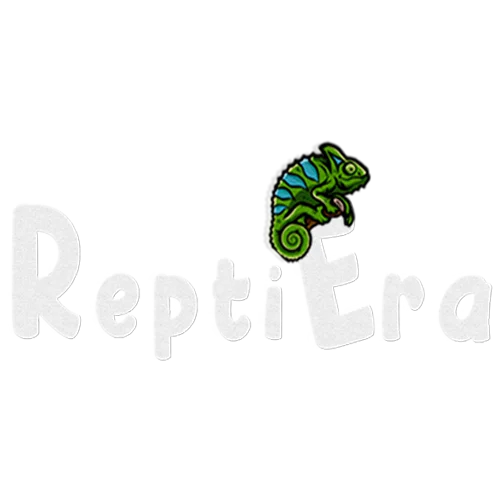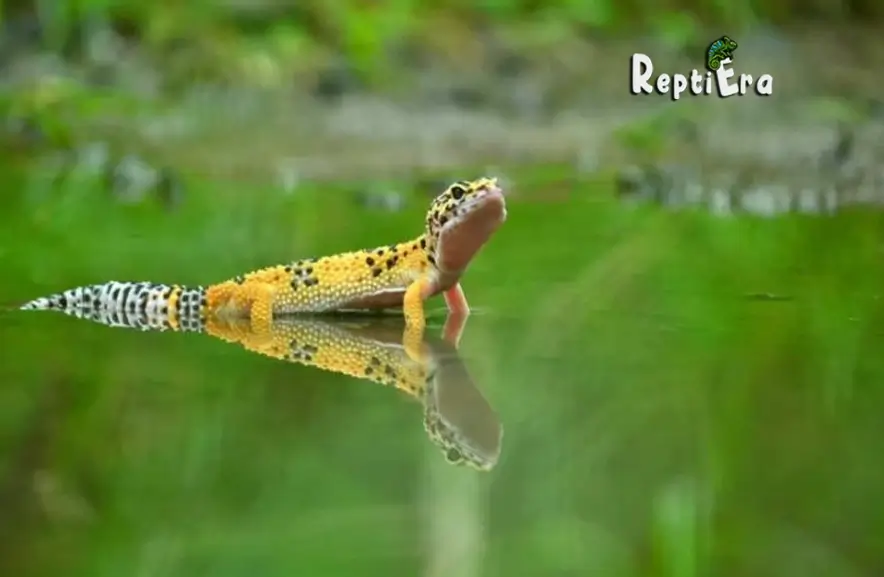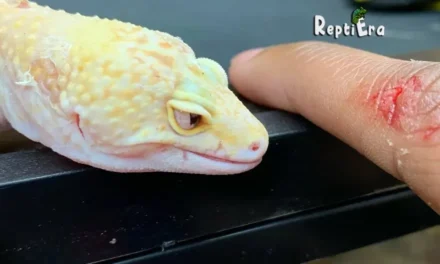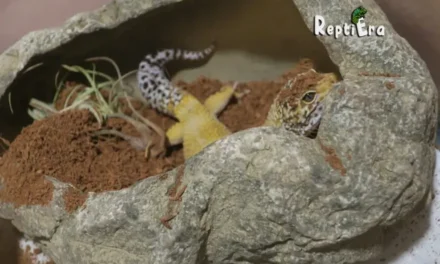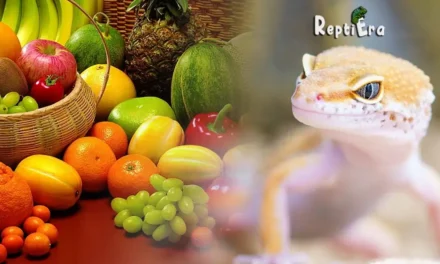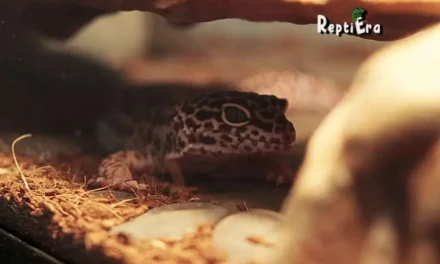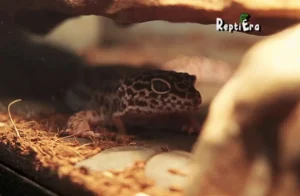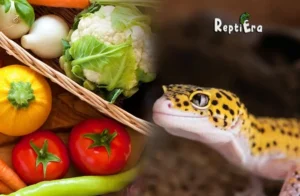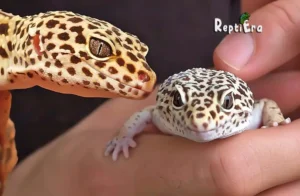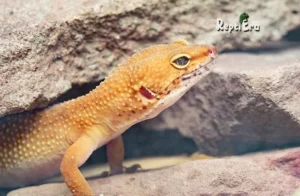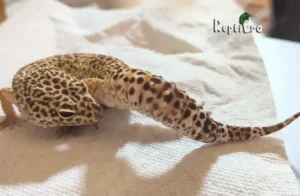As a seasoned reptile enthusiast, I’ve observed that leopard geckos, hailing from dry, arid regions, typically don’t encounter pools or large bodies of water in their natural habitat. It’s uncommon for these creatures to swim, as they’re not built for it. This background sets the stage for addressing the quick answer to whether leopard geckos need baths.
In essence, they do not require regular or deep immersion in water. However, a shallow, warm water soak can be beneficial for specific situations. For instance, during sheds, when remnants might cling to their toes or feet, a gentle bath helps.
Additionally, it aids in cleaning their femoral pores, preventing blockages. Pet owners should ensure the water is only deep enough to cover the gecko’s belly, providing a safe and stress-free experience. While they cannot dive or be submerged, a brief, supervised bath can contribute to keeping them clean and healthy.
Table of Contents
Leopard Geckos Don’t Love Water
Originating as desert-dwelling creatures, leopard geckos are not naturally excited about jumping into a pool of water. In the desert, water is a rare resource, and while they do need it for drinking, the idea of taking a dip or a float is alien to them. They often flail around in deep water, as they can’t swim, making it a stressful experience. Therefore, bathing or soaking them is generally not advised. However, misting can be beneficial, providing hydration without the stress of immersion.
Tip: It’s important to set the right expectations: while there might be the occasional exception, most leos do not love water. Understanding this natural aversion helps in providing care that aligns with their instincts and ensures their well-being.
Bathing Vs Soaking
First things first, let’s clear up the difference between bathing and soaking, as these terms are often used interchangeably but have distinct definitions. Bathing typically refers to washing the leopard gecko with water, but it’s crucial to note that it should never involve human soap or scrubbing like a human bath.
The term soaking, on the other hand, suggests just sitting in shallow water—just enough to reach the bottom of their belly. In most cases, soaking is a more accurate description of what these reptiles occasionally need. The mix-up in terminology can lead to confusion, so in this article, when we say “bathing,” we’re really using a less aggressive approach to clean these delicate creatures.
When Do Leopard Geckos Need Baths?
When exactly do leopard geckos require a soak or bath? Here are the top three situations where it’s typically necessary.
1. Removing tight or leftover skin from shedding
Most of the time, leopard geckos can shed their skin without any problem, but occasionally, they might have extra skin clinging to their toes or stuck-on skin that’s tighter and can lead to issues like losing a toe if not addressed. To assist them, a shallow soak or strategic misting can help moisten the skin, making it easier to remove.
I often use a Q-tip for this purpose, carefully avoiding any metal or tougher material that might be too harsh for their fragile skin. This gentle method ensures the safe removal of any residual shed, aiding in their overall well-being.
(This YouTube video does a great job showing you how to remove a stuck-on toe shed safely and gently:)
2. Unclogging femoral pores
During the breeding season, male leopard geckos often secrete a waxy substance containing pheromones from their femoral pores, which are “V” shaped slits located near their tail. These secretions, while natural, can become clogged and lead to red, infected areas if not kept clean.
In my experience with these reptiles, regular rubbing against bark or rocks—naturally coarse materials in their habitat—helps maintain these pores. However, when they are noticeably sore or swollen, a gentle, warm soak can soften this buildup, making it easier to dislodge. I’ve found that using a Q-Tip or cotton swab for a gentle rub is key to treating these uncomfortable areas, ensuring not to be too aggressive as their nether regions can be tender and shouldn’t be prodded harshly.
In cases where you’re seeing persistent issues, it’s crucial to consult a qualified vet to examine your lizard, as they can provide specialized care for your pet’s unique needs.
3. Constipation or Impaction
Impaction and constipation are big topics in the reptile community, especially when describing leopard geckos. These conditions refer to a blockage in the GI tract, often related to what the gecko has eaten. When a gecko ingests materials that obstruct its digestive system like impacted loose substrate from its habitat or eating something large and difficult to digest, the risk of constipation increases.
Being careful with their diet is crucial, but sometimes a soak in warm water while massaging their belly can help to dislodge the poop. This rub, focusing from the chest to the tail, can alleviate their discomfort.
In instances where constipation or impaction is suspected, daily soaks for several days may be necessary to help clear the blockage. It’s common for reptiles, not just herps like frogs and toads, to defecate during or after a bath. However, if the problem persists or is heavily impacting the gecko’s health, it’s imperative to consult a qualified vet.
It’s also essential to be mindful of the substrate used in their habitat, avoiding inappropriate or dangerous materials like sand or tough materials, which can contribute to these issues. Crickets and other insects should be sized appropriately to ensure they can be easily digested and not cause problems.
Related Post: WHY IS MY LEOPARD GECKO LICKING HIS BUM
How To Safely Bathe Your Leopard Gecko
While it’s established that leopard geckos occasionally need a bath or soak, doing it safely is crucial to pull off this care routine effectively. Regular bathing isn’t necessary for these creatures, but when covered in residue or during shedding, a bath can be beneficial. To give your gecko a safe bath, ensure the water is shallow enough to avoid any risk of drowning, warm but not hot, and devoid of any soaps or chemicals. Gentle handling during the process is essential to prevent stress or injury.
1. Wash Your Hands Before and After Handling Your Gecko
Like many reptiles, leopard geckos can carry the Salmonella bacterium, posing a risk of health problems if it’s transmitted to humans. Conversely, humans can transmit various germs and bacteria to the gecko. The importance of washing your hands thoroughly before and after handling your gecko cannot be overstated.
This practice is crucial for both the cleaning process and general interaction. Using lukewarm water and mild soap is sufficient to reduce these risks and ensure the health and safety of both you and your pet.
2. Gather Your Supplies

Before you get started with bathing your leopard gecko, it’s essential to gather all the necessary supplies. You’ll need a shallow dish that is not too tall for the gecko to climb out of, but wider than your hands to give it enough space. Place a paper towel or a sturdy cloth at the bottom of the dish to provide grip and prevent slipping on the smooth surface. This setup not only makes the dish/container more comfortable for your gecko but also helps to reduce stress during the bath. Whether you’re working on removing shed skin or unclogging pores, having Q-tips ready at hand is also advisable for gentle cleaning.
3. Add Warm Water
Once everything is ready, it’s time to add warm water to the bath. The ideal temperature should be between 85 and 90 degrees Fahrenheit (29 and 32 degrees Celsius). This range is warm enough to not let the gecko’s temperature drop during the bath, but not too hot to harm their scaled skin.
Note: Always keep an eye on the water temperature, as it can cool down towards the end of the bath. If necessary, swap out the cooler water for warmer water. Using a thermometer is advisable to ensure accuracy. The water should be comfortable to the touch; if it feels uncomfortable for you, it’s likely too hot for the gecko.
Avoid using soap or tap water that may contain harsh chemicals; instead, filtered or bottled water is a safer bet to play it safe.
4. Keep the water shallow.
When bathing a leopard gecko, it’s vital to keep the water level no higher than the leopard gecko’s belly, especially if you’re trying to remove a stuck-on toe shed. Ensure the Leo’s toes can touch the bottom and the gecko’s head remains above water at all times, as they cannot swim and don’t have a protective membrane over their ears.
If water goes under their ear level, it might get inside, which can be harmful. Stay with your leopard gecko the entire time they are in the water, offering support and ensuring their safety. It’s best to gently hold them to provide security and comfort in the water.
5. Do Not Rub Your Gecko
When dealing with retained skin that doesn’t come off after repeated soakings, never try to pull or brush it off, as this could damage your reptile’s delicate skin, muscle, or even the underlying bone. If your pet has skin that hasn’t moulted and it lasts longer than 2 weeks, or if they’re suffering from a possible skin infection or illness, they should be checked out by a reptile-savvy veterinarian for professional care.
Also Read: WHY IS MY LEOPARD GECKO ALWAYS HIDING
6. Soak
To effectively soak your leopard gecko, place them in warm, shallow water for about 10 to 15 minutes. You can use a small tub or a Tupperware container for this job. If the soak needs to be longer, remember to refresh the water if it gets too cold. In certain situations, this time is crucial for their hygiene. Make sure to stay with your gecko the entire time of the soak. Once they start to relax, you can begin using a Q-tip to clean their femoral pores or remove any stuck-on shed. Even just a few minutes in the soak can significantly aid in their shedding process and overall cleanliness.
7. Dry
After the soaking session is complete, and you replace the water to keep it warm until you finish the bath, it’s crucial to dry your leopard gecko thoroughly. Using paper towels is often best for this purpose, as they’re clean, dry, and free from any irritants. Alternatively, a cloth that is soft and absorbent can also work, provided it doesn’t contain artificial fragrances that could irritate their fragile lungs and skin. Ensuring your gecko is completely dry after their bath is essential for their comfort and health.
Too Much Bathing Can Dry Out Leopard Gecko Skin
It’s easy to think that a bath can be a regular treat for a leopard gecko, but it’s important to know that doing this as a regular occurrence is not only unnecessary but can be harmful. Although we’ve talked about how some leos may seem to enjoy water, too much of it can dry out their skin, leading to various problems. This is true for many species, including humans, as excessive bathing can remove the natural oils that keep their skin healthy. Therefore, it’s essential to keep bathtime to a minimum to reduce stress on Leo’s skin and maintain their overall health. These reptiles frequently love to dig and stay clean in their unique ways.
Also Read: WHY DO LEOPARD GECKOS LICK THEIR LIPS
Do Leopard Geckos Need Misting?
While we’ve talked about bathing and soaking, misting also falls into the care routine of leopard geckos. They need a dry environment, typically around 30% to 40% humidity, as part of their regular care. However, misting can be helpful particularly when dealing with stuck-on sheds. It’s beneficial to create a humid hiding spot outside their enclosure as one of the tools for helping with this problem. The mist helps loosen the skin, especially around the toes or on the entire body, aiding in a smoother shedding process.
FAQs
How often should you bathe a leopard gecko?
Leopard geckos should be bathed rarely, only when there’s a need due to clogged femoral pores (common in males), stuck on shed around toes, or to help with mild constipation. Bathing can put your Leo under stress, so it’s worth considering only in these specific circumstances.
Do leopard geckos need to be cleaned?
Leopard geckos don’t need regular bathing to stay clean, as they are quite adept at handling themselves. If they are constantly dirty, it’s a good idea to evaluate your husbandry protocols for possible improvements, rather than resorting to bathing the leopard gecko. Their natural grooming habits typically keep them in good condition.
Can you put a leopard gecko in a tub?
You shouldn’t put a leopard gecko in a human tub; instead, opt for a small dish or Tupperware for bath time. Bathtubs are too large and hard to manage for small leopard geckos, making it challenging to ensure a safe and appropriate water level, which should only reach their belly.
Can leopard geckos bathe in tap water?
In most cases, tap water is fine for bathing a leopard gecko, but its quality can vary widely depending on the specific region. If you’re unsure, it’s a good idea to use bottled water to bathe your leopard gecko, ensuring it’s appropriately warmed up to a comfortable temperature.
Do leopard geckos like to be in water?
No, leopard geckos do not typically enjoy being in water. As desert-dwelling creatures, they are not commonly exposed to large bodies of water in their natural environment and are poor swimmers. Being in water can be stressful for them, though they can tolerate it briefly if just their toes and belly need a bath.
Is tap water safe for leopard geckos?
Depending on where you live, tap water can be safe for your leopard gecko, but it’s often best to use filtered or thoroughly boiled water to bathe your gecko. Filtering the water helps ensure that no harm comes from potential infection due to unclean water.
Can leopard geckos drink water through their vents?
Although some amphibians and reptiles are believed to drink water through their vents during baths, this hasn’t been proven in geckos. Scientists have shown that lizards, including leopard geckos, do not typically take up water in this way in water. However, they will lap up and drink water while soaking.
Do leopard geckos need warm water?
Unlike snakes, geckos tend to shed their skin in pieces, and they commonly retain unshed skin around their eyes and toes. These areas can be effectively soaked in shallow, warm water to increase hydration and encourage shedding.
How often do you bathe a leopard gecko?
Additional soaks in shallow, warm water for 15-20 minutes, about 2-3 times a week, can be helpful during their shed cycle. However, leopard geckos will not go into the water on their own, so it’s important to place them in a shallow container but never force soak them against their will.
Conclusion
In conclusion, while leopard geckos do not require frequent baths as part of their routine care, occasional shallow, warm water soaks can be beneficial in specific circumstances such as aiding with shedding, addressing mild constipation, or cleaning clogged femoral pores. It’s crucial to ensure that the water temperature is comfortable and that the gecko is never forced into a stressful situation. Leopard geckos typically maintain their cleanliness and rely on their natural grooming behaviours. As owners, it’s important to respect their natural habits and preferences, providing baths only when necessary and ensuring their overall well-being. Remember, the key to a healthy leopard gecko lies in understanding and catering to their specific needs while minimizing stress and discomfort.
